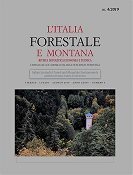The “mena delle bufale” (buffalo grazing): a particular approach for riverbed clearing and maintenance
Published 2019-10-03
Keywords
- riparian vegetation management,
- land maintenance,
- prevention of hydrogeological instability
Copyright (c) 2019 Italian Journal of Forest and Mountain Environments

This work is licensed under a Creative Commons Attribution-NonCommercial 4.0 International License.
Abstract
Riverbed clearing is that complex of operations, all part of the ordinary maintenance of the hydrographic network, which includes cutting riparian vegetation and removal of silting. These are periodic operations, are essential to keep the outflow lines efficient, counteracting natural dynamics that can cause the loss of hydraulic functionality of the waterways. The restoration of the hydraulic functionality is a topic that has long been addressed in the context of land management actions. Here we describe the origins, development and decline of a traditional livestock system, based on buffalo breeding, used for the maintenance of the hydraulic network in the plains of the Campania region: the “mena delle bufale”, which has been practiced at least from the XVII to the XIX century. On the basis of the available historical documentation we illustrate the technique applied in a particular historical moment and in a particular territorial context as an example of a sustainable approach for riparian vegetation management.

